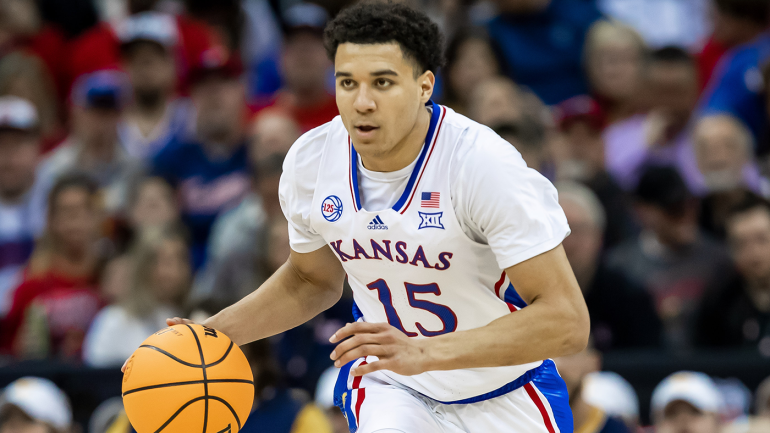
Another Selection Sunday come and gone, which means the 2023 NCAA Tournament bracket is finally in our hands. Now the question becomes how best to keep your bracket from taking a one-way flight into the trash can after watching your national champion lose to a No. 15-seed on the first afternoon of the Big Dance.
That means it's once again time to break out the ol' Flagrantly Unscientific Natty Kalculator (FUNK) and determine with absolute certainty the only teams that can actually win the national championship in three weeks. For the uninitiated, the FUNK is a tried-and-true method which has (almost) never failed to correctly identify the national champion using a series of historical trends.
In recent years, we've started off by immediately cutting out everyone below a No. 5 seed (over 70% of the field) because only four champions in the seeding era were seeded 6th or lower. But these days, double-digit seeds make runs to the second weekend with regularity, and a No. 8 seed in last year's national championship nearly sunk the FUNK.
So, without further ado, let's kick this off with a brand new rule ...
Brackets are here! Get back in your pools and join our Men's and Women's Challenges for the chance to win a new SUV and a college basketball dream trip!
Rule 1: The road not taken looks real good
Unlike the old No. 1 rule (the cream has already risen to the top), this doesn't have a single exception since NCAA Tournament seeding began in 1979. A national champion must enter the tournament with at least one road/neutral win over a fellow tournament team. (The last champion that didn't was 1977 Marquette, nearly 50 years ago.) Just like that, we've culled almost a third of the field without summarily throwing away seeds based on number alone. Twenty teams failed this entry level test, including 17 automatic qualifiers and a trio of at-large programs: Nevada, NC State and Providence. Hit the road a little harder next year.
Eliminated: Colgate, Charleston, Fairleigh Dickinson, FAU, Furman, Grand Canyon, Howard, Kennesaw State, Louisiana, Montana State, Nevada, NC State, Northern Kentucky, Princeton, Providence, Southeast Missouri State, Texas A&M-Corpus Christi, Texas Southern, UC Santa Barbara, UNC Asheville
Rule 2: The first time, you have something to lose
Only once since the tournament expanded to 64 teams in 1985 has a team gone all the way in its first Final Four appearance: UConn back in 1999 (and they've won three more titles since). So, our next group of eliminations will be everyone left in the field who's never been part of the mythical quartet at the end. That's bad news for overall No. 1 seed Alabama as well as Tennessee, Xavier and 16 others. Research recommends making this year's Final Four so you have a chance to win it next time you're there.
Eliminated: Alabama, Xavier, Tennessee, San Diego State, Saint Mary's, Miami (FL), Creighton, TCU, Texas A&M, Missouri, Northwestern, Boise State, Utah State, Pittsburgh, Arizona State, Oral Roberts, Kent State, Iona, Vermont
Rule 3: In my defense, I have one
Everyone knows "defense wins championships," but really, it's adjusted defensive efficiency that gets the job done. Every national champion since 2001-02, the first year KenPom has complete efficiency data, has finished in the top 20. So, we're eliminating everyone outside the top 20, right? Not quite. Those rankings aren't set until the season ends, and teams will move quite a bit during the tournament. Going the Casey Kasem route and opening it up to the top 40 heading into the Big Dance hasn't steered the FUNK wrong yet, but even lowering the bar to 40 means the end of Gonzaga's consideration.
Eliminated: Arizona, Marquette, Baylor, Gonzaga, Indiana, Kentucky, Iowa, West Virginia, Penn State, USC, Drake
Rule 4: What's the point of keeping score?
You only need to be able to count to "one" to enforce the next rule: Any team that has not already won a championship this season -- either a share of the conference regular-season crown or a tournament title -- is getting the boot. Why? Because in the last 32 NCAA Tournaments, only three teams have won a national title without a conference crown: 1997 Arizona (no conference tourney crown), 2014 UConn (an outlier in just about every way) and 2015 Duke (no ACC titles). Bottom line: champions win championships.
Eliminated: Kansas State, UConn, Iowa State, Michigan State, Arkansas, Maryland, Auburn, Illinois, Mississippi State
And that leaves us with eight teams ...
Rule 5: Dancing like he's made of starlight
In the end, the national championship will be decided by the players on the floor, and recent history shows that you just don't win natties without future pros. All but four champs since 1995 had a player selected in the first round of that year's NBA Draft, and the ones who didn't (1997 Arizona, 2006 Florida, 2010 Duke and 2016 Villanova) all had multiple future pros return to school after their title runs. Because it's early in the draft process, we'll allow anyone in the CBS Sports top 60 prospects -- projected to be drafted this year at all -- to qualify as a future pro. But that's still gonna mean curtains for No. 1 seed Purdue and others.
Eliminated: Purdue, Memphis, VCU, Virginia
Rule 6: It's blue, the feeling I've got
Doesn't this all feel a little too legitimate for something that has "Flagrantly Unscientific" in the title? Well, prepare to get extremely illegitimate, because the last qualifier is the patently absurd "blue rule." Only two of the last 18 teams to win the national championship did so without a shade of blue as one of its official colors. Who am I to argue with an 88.9% success rate over the last 18 tournaments? If you don't wear blue, the FUNK has no time for you.
Eliminated: Houston, Texas
Which leaves us with ...
... just three legitimate candidates to win it all out of the entire field of 68: Duke, Kansas and UCLA.
















